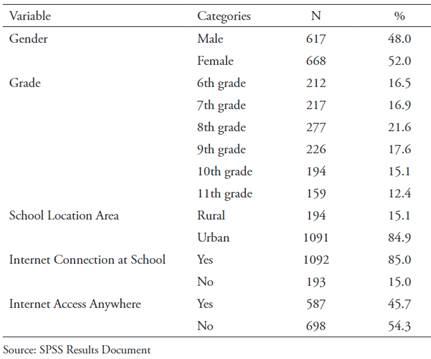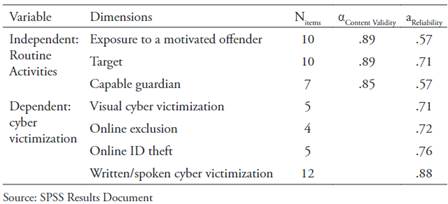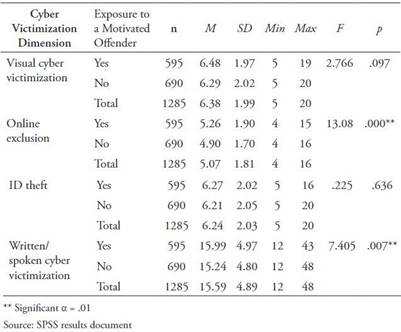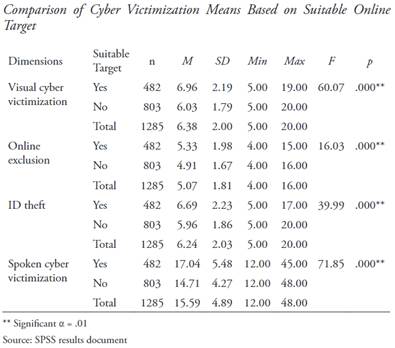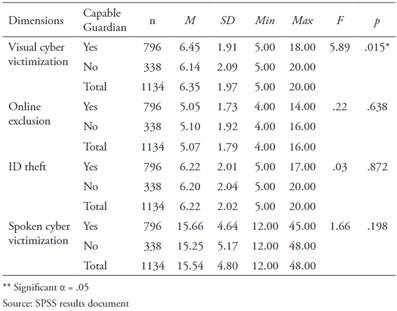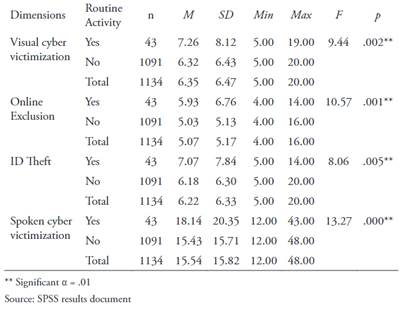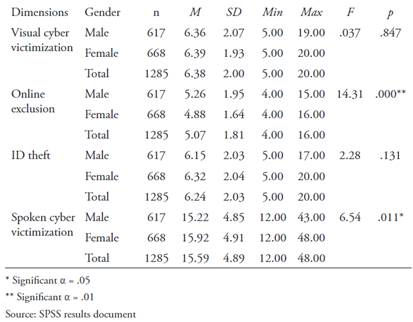Digital convergence has been addressed by countless authors who have provided a reflective look to the issue by analyzing the possible influence of this phenomenon on various sociocultural, technological, media, and academic contexts, among others. According to García (2009), it is “a term that has been used since the mid-eighties to refer to a variety of issues related to the technological transformation introduced by digitalization in the development of telecommunications” (p.104). Jenkins (2008) understands convergence as “culture of media convergence, which supposes the existence of a content flow supported by multiple media platforms, in the cooperation between multiple media industries and in the migratory behavior of media audiences” (p.15). In general, digital convergence is a multidimensional process that affects the cultural practices of society (Bárcenas, 2013).
Studies on digital convergence have traditionally been framed toward understanding this phenomenon from the perspective of communication. However, the social processes derived from the technological unification of this global age have demanded the extension of these studies to new cognitive and thought approaches, configurations leading to collective talks, and generation of new knowledge in the necessary intersection between communication and education.
In fact, from this interdisciplinary integration, one of the aspects that has managed to capture the attention of researchers in both areas of knowledge is related to the influence of routine activities of school children and teens in the risks of using the Internet with emphasis on cyberbullying. Routine activities that frame the behavior of school children and teens with access to various digital platforms or Information and Communication Technologies (ICT) must be addressed by researchers in the social sciences for their potential in identifying risks that may affect the emotional, physical, or academic well-being of this population.
Undoubtedly, the identification of some of the factors and behaviors that may generate risks when using the Internet allows communicators and educators to establish joint prevention strategies for the protection and safety of school children and teens. In addition, it would result in the configuration of thought paradigms and explanatory theoretical models that contribute to the reformulation of management designs and intervention on the appropriate use of ICTs. Amador (2012) points out the coincidences in the cyberculture and hypermediation approaches, indicating that there are three underlying registers that clarify “the relationship between communication, media, and digital technologies versus the subjective and social transformations of the subject: other ways to assume reality; new ways of managing participation; and a rupture of totalization through interactive creation” (p.3).
This new way of assuming the reality proposed by Amador (2012) suggests the need to analyze how the routine activities of children and teens in the network favor their vulnerability to different situations in the virtual space, including cyberbullying. As stated by Miró (2011), “…the risk size generated by the gigantic dimensions of this new social communication space would be different if they had a smaller scope” (page 7).
From the perspective of communication, education, and psychology as interconnected disciplines, it is imperative to analyze whether, in the Colombian context, the access of school children and teens to new independent or collective spaces, characterized by digital convergence, exposes them to some inadequate conducts, including cyberbullying. In this sense, the routine activity theory (RAT) proposed by Cohen and Felson (1979) is applicable to cyberspace and its derivatives due to the relevance it has in understanding the age of digital convergence and the use of the Internet as practices fostering new ways of social interaction between school children and teens.
RAT and Cyber Victimization
The routine activities of children and teens in the network may make them vulnerable to different risks since, as Miró (2011) states, they become risky due to the size and scope of this space used for interaction and communication, in which time and distance are exceeded. Cohen and Felson (1979), authors of the RAT, define this type of activity as “any recurrent and prevalent practice that satisfies the basic needs of the population and individuals, including formal work, leisure, different ways in which people get food and shelter, social interaction, teaching, sexual expression, etc.” (p.593). Given its characteristics, cyberspace becomes a stage for cyber victimization. This theory, as applied to cyberspace, emphasizes three interdependent variables: suitable online target, described as Internet usage behaviors from a thing or person who is a suitable crime target; exposure to an online motivated offender, defined as activities that expose individuals to a cyber-offender when connected to the Internet, and finally, capable guardian, which is classified as those people, individual tactics, and technological tools that may prevent potential cyber-crimes (Rodríguez, Oduber, and Mora, 2017).
Some studies on this topic have advanced into the understanding of RAT from different social contexts, resulting in the development of innovative reflections that contribute to further understanding and analysis of this theory starting from a broad perspective. Based on these studies, some of the variables related to the development of risky behaviors that are detrimental to ICT users have already been identified (García-Guilabert, 2016; Álvarez, 2015; Sasson and Mesch, 2014; Llinares, 2012; Pratt, Holtfreter, and Reisig, 2010).
In this sense, in the context of social networks, studies related to RAT have been subject to the identification of some actions performed by Internet users, or intervening variables, which could be classified as risky behaviors for the population who usually uses modern technologies (Shin and Huh, 2011; Sengupta and Chaudhuri, 2011), as well as actions that are subject to the type of communication device and social network used during the interaction process (Reyns and Henson, 2015; Mitchell, Wolak, and Finkelhor, 2008, Lee and Chae, 2007).
In this research, our analysis focuses on risky behaviors related to cyberbullying, with emphasis on cyber victimization. Cyberbullying has been defined by the Office of the Special Representative of the UN Secretary General on Violence Against Children of the United Nations Organization (2016) as “An aggressive, intentional act carried out by a group or individual using electronic forms of contact, repeatedly and over time, against a victim who cannot easily defend him or herself. This act may include dissemination rumors; posting false or unpleasant messages, embarrassing comments or photos; or excluding someone from online networks or other communications. It is characterized by an imbalance of power and the damage it causes can be profound” (p.14). According to Bauman and Bellmore (2015), the term cyberbullying was popularized by Bill Belsey in 2003, when he launched his www.cyberbullyning.ca website, stating that “although the term had been used in 1993, it is not until 2003 when its use becomes generalized” (p. 1).
Cyberbullying among children and teens has received significant attention from academic researchers in recent years (Kowalski et al, 2014; Cowie et al, 2013; Bauman, Cross, and Walker, 2012; Menesini, Nocentini, and Calussi, 2011; Hinduja and Patchin, 2008). According to Patchin and Hinduja (2006), cyberbullying has been empirically linked to multiple bad emotional, psychological, and adaptive behaviors; hence, its empirical approach is complex.
Just as there are multiple definitions and approaches around cyberbullying, Brown, Demaray and Secord (cited by Kalia and Aleem, 2017a) sustain that there is no standard conceptualization for cyber victimization; however, they suggest that all concepts related to this term contain, among their characteristics, the element of intentional and repeated harm inflicted through the use of technology. The studies on cyber victimization have involved various theories and methodological propositions to explain this phenomenon with a cross-sectional approach. Some have emphasized the development of scales to further analyze victimization through online social services (Akbulut, Sahin, and Eristi, 2010), while other investigations have framed the object of study to the psychological perspective, consequences, identification of the possible factors of online teen victimization; role of the school in the prevention of this risk; and role of social inequality and networks in cyberbullying(Koutamanis, Vossen, and Valkenburg, 2015; Bauman, Cross, and Walker, 2012; Bauman, 2009; Dilmac, 2009; Dehue, Bolman, and Vollink, 2008; Beran and Li, 2007; Cohen, Kluegel, and Land, 1981).
Cyber victimization is one of the risk behaviors most frequently discussed by recent studies related to the routine activity theory (Arntfield, 2015; Ito, 2013; Livingstone, 2008; Hinduja and Patchin, 2008). According to Marcum (2008), spending a lot of time connected to the Internet, communicating, and sharing personal information online increase the likelihood of being a cyberbullying victim. For the purposes of this research, cyber victims are people who are at the receiving end of cyberbullying behaviors (Kalia and Aleem, 2017b) and who may be related to some of the aforementioned characteristics defined by the routine activity theory (suitable online target, exposure to a motivated offender, and capable guardian).
From the perspective of this study, it is important to determine whether the cyber victimization phenomenon is applicable to Colombian students, considering the guidelines established by the routine activity theory. The findings of this research will serve to establish the explanatory scope of the Theory for the cyber victimization phenomenon in students between 11 and 18 years old and to determine if it is consistent with the studies conducted so far. In addition, they may serve as a foundation for the development of new lines of research using the variables proposed herein. Likewise, these results generate suggestions on prevention matters, which may be used by the government and other public institutions for the design of public policies on these issues.
Purpose of Study
Aligned with the aspects highlighted in the theoretical framework, the variables of this study are as follows: Routine Activities are considered as the independent variable of the study. Its dimensions applied to the cyberspace context are a) suitable online target, b) exposure to a motivated offender, and c) capable guardian. The dependent variable was cyber victimization, with four dimensions defined by the questionnaire authors (Álvarez-García, Dobarro and Núñez, 2015), namely, a.) visual cyber victimization, b.) online exclusion, c.) identity theft, and d.) written/spoken cyber victimization. As specified above, the purpose was to determine if there is an influence of the routine activities of Colombian school children and teens in cyber victimization.
The study of these variables and dimensions was addressed through a field study and quantitative approach. The research hypothesis was as follows:
H1. Routine Activities (suitable online target, exposure to a motivated offender, and capable guardian) have a statistically significant influence on the cyber victimization of school children and teens in Colombia.
The reasons that justify this study are as follows:
From the theoretical point of view, more academic research is required to focus on the study of routine activities and their influence on the risks to which school children and teens are exposed, due to their importance for the identification of intervening process variables. This would allow communicators and educators to establish guidelines to design subsequent prevention strategies aimed at the protection and safety of school children and teens. In addition, the analysis would result in the configuration of new conceptual perspectives and the possible development of explanatory models that contribute to the reformulation of management and intervention designs on the appropriate use of ICTs for the benefit and protection of school children and teens.
From a methodological perspective, it should be mentioned that there is a gap in Latin America of empirical studies, with an emphasis on quantitative methodology developed in the field of communications and education, which may explain the way in which the routine activities of school children and teens have some influence on the risks associated with Internet usage, thus fostering opportunities for the development of cyberbullying behavior and particularly, of cyber victimization. Likewise, the understanding of this process through the information collected in the sample under study with strict measurement scales tends to the adequate interpretation of the data, statistical analysis, and possible replications of this study in other sociocultural contexts.
Regarding practical justification, as noted, the results obtained can contribute to the development of prevention and joint intervention strategies among communicators and educators for improving the emotional, physical, and academic performance of school children and teens.
Method
Participants
Data were collected from 1285 female (52%) and male students from grades 6-11, from 15 public schools, both in the urban area (84.9%) and in the rural areas of Antioquia and Chocó (Colombia). 85% of students indicated that their school has an Internet connection and almost half were able to access the network from anywhere (Table 2).
Measures
A three-section self-administered questionnaire was designed. The first section was a questionnaire designed by researchers to measure the three RAT dimensions proposed by Cohen and Felson (1979). This questionnaire was submitted for expert validation and a content validity coefficient greater than .8 was obtained, which is considered optimal. The second section contained the cyber victimization questionnaire by Álvarez-García et al. (2015), which comprises four dimensions. The last section explored aspects such as gender, academic degree, school location area, and Internet connection (Table 1).
We calculated the reliability of the items that constituted the three dimensions of RAT (Table 1) using the K coefficient of Richardson because they are dichotomous variables. In the case of the Risk Exposure dimension, the KR21 value was .57; for the suitable target dimension, the value was .71, and for capable guardian, the value was .57. Although these results do not reach the optimum value, they can be considered reliable, considering that, according to Nunnally (1967, cited by Frías-Navarro, 2014), “In the first phases of research or exploratory studies, a reliability value of .6 or .5 can be enough” (page 3). In addition, we calculated the dimension reliability for the cyber victimization questionnaire by Álvarez-García et al. (2015) using the Cronbach’s Alpha coefficient, as they are additive scales. The results indicated internal consistency of the four dimensions (visual cyber victimization α = .71, online exclusion α = .72, ID theft α = .76, and written/spoken cyber victimization α= .88), as well as for the full instrument (α = .94).
Routine Activity Questionnaire: This questionnaire was created ad hoc by the researchers and comprises 27 items that inquire about the participants’ routines on the Internet during the last two months to determine what made them vulnerable in cyberspace. The theoretical definitions expressed by Cohen and Felson (1979) were considered for the design of the items in this questionnaire, which point out three dimensions: exposure to a potential motivated offender; suitable online target, and capable guardian, already previously described. For the first dimension, nine items were proposed with an affirmative or negative response. To define as exposed to a motivated offender, the affirmative answer to seven or more items was taken as a criterion.
The second dimension was translated operationally into ten items that represent behaviors that young people acknowledge doing and which expose them to being victimized, considering as such those cases where there are five or more affirmative answers. Regarding the capable guardian dimension, it was operationalized from seven items that include the practices or habits that may protect users from cybercrime, as well as activities performed by parents or other family members to control children on teens in cyberspace or which can make them feel controlled (García-Guilabert, 2016). The affirmative response to at least six items reveals the existence of a risk due to the absence of a capable guardian.
Cyber Victimization Questionnaire by Álvarez-García et al. (2015): The questionnaire comprises 26 items, measured on a Likert scale of frequency (1 = never, 2 = few times, 3 = many times, 4 = always), distributed in four dimensions, namely, visual cyber victimization (five items), online exclusion (four items); ID theft (five items), and written/spoken cyber victimization (12 items). The scores for each dimension were obtained from the sum of the items of each dimension.
Procedure
After the questionnaire was designed, it was hosted on the Google platform and students were asked to answer it online. Stratified and conglomerate random sampling was used. The strata were formed by the six grades that correspond to middle and secondary school in Colombia (6-11). The conglomerates corresponded to a group from each degree at each educational institution to guarantee the representativeness of the sample. The questionnaires were answered anonymously by the students, with prior informed consent, in the computer rooms at each educational institution under the supervision of a teacher, who did not interact with the respondents. The data were stored in Excel and processed with SPSS 21.
In the descriptive analysis, averages and standard deviation were used for the additive scales, and in the case of the categorical variables, frequencies and percentages were used. The averages of the cyber victimization dimensions were compared according to the exposure, objective, and guardian groups using the Unifactorial Variance Analysis of Fixed Effects at a significance level of 5%. The null hypothesis for equal cyber victimization means of the study groups was subjected to contrast.
Results
The three dimensions of the variable routine activities were explored. The first, exposure to a motivated offender, was measured from nine items that reflected the activities that the person does and that expose him/her to risks in cyberspace, such as having a computer with an Internet connection, using social networks, downloading games and music, and not having programs that prevent remote Webcam activation. The presence of at least seven of these behaviors was considered as exposure to a motivated offender and allowed to classify 46% of the participants as exposed.
The second dimension, suitable online target, refers to 10 behaviors that make children and teens a target for victimization, such as having had contact or initiating friendships with strangers through the Internet, publishing photos or videos or storing personal information on their mobile phones or tablets. Showing five or more of these behaviors represented that children or teen constitute a suitable online target. With this criterion, it was found that 37.5% of participants are considered suitable targets in cyberspace.
The third dimension, capable guardian, was measured from seven items that refer to the performance of activities that may prevent or foster crimes, such as adult supervision and connection from public computers or from mobile phones. The performance of at least six of these practices constitutes the existence of risk due to the absence of a capable guardian and in the sample, 29.8% of the participants did not have a capable guardian who may protect them.
Regarding cyber victimization that constitutes the dependent variable of the study, Álvarez-García et al. (2015) indicate four dimensions: visual cyber victimization (five items), online exclusion (four items), ID theft (five items), and written/spoken cyber victimization (12 items). These variables were rated based on the sum of the answers given by teens to the items on a Likert scale of frequency ranging between 1 (“never”) and 4 (“always”). In this sense, visual cyber victimization, and ID theft had a theoretical fluctuation between 5 and 20 points with a theoretical average of 12.5 points. Online exclusion fluctuates between 4 and 16 points, with an average of 10 points. Written/spoken cyber victimization comprised 12 items ranging between 12 and 48 points with a theoretical average of 30 points. A higher score on the scales indicates greater cyber victimization.
Empirically, in the students from grades 6 to 11, all averages of the cyber victimization dimensions are below the indicated theoretical average, even in the lower quarter of the scale, while reflecting little variability. In this order of ideas, the average visual cyber victimization was 6.4 ± 1.99 points. Similar results were recorded in the ID theft dimension, with a mean of 6.23 ± 2.03 points. In the online exclusion dimension, the average was very close to the minimum score of the scale, namely 5.1 ± 1.81 points. On the other hand, the average written/spoken cyber victimization was 15.6 ± 4.89 points; this value being almost half of the theoretical average of 30 points. These averages reveal that cyber victimization tends to be located at the lower end that corresponds to a low frequency of this risk, while reflecting the “never” response in the alternatives.
Considering that the dependent variable is formed by four dimensions in additive scales, which makes it a quantitative variable, and that the independent variable is constituted by the three dimensions of the routine activity theory measured in a dichotomous way (presence or absence), the Unifactorial Variance Analysis of Fixed Effects was used at a significance level of 5%. Consequently, the following null hypothesis of equal cyber victimization means was subjected to contrast:
H0: Exposure to a motivated offender, being a suitable target, and not having a capable guardian does not influence in a statistically significant way the averages of the four cyber victimization dimensions.
Exposure to a Motivated Offender and Cyber Victimization
It is observed in Table 3 that the averages of the online exclusion and written/spoken cyber victimization scales for those subjects who were classified as exposed to a motivated offender are higher than the averages for those not exposed, and these differences are statistically significant (p < .01). In the visual cyber victimization and ID theft dimensions, there was no influence of the exposure to a motivated offender variable, since the probability values associated with the F statistic do not support rejecting the null hypothesis. It is, therefore, concluded that the aforementioned exposure affects online exclusion (F = 13.08, p = .000) and written/spoken cyber victimization (F = 7.405; p = .007) but not visual cyber victimization (p = .097) or ID theft (p = .636).
Suitable Target and Cyber Victimization
The second dimension of the RAT refers to the activities that make subjects attractive targets for offenders. The results in Table 4 show that all cyber victimization averages present statistically significant differences. That is, suitable targets report a higher cyber victimization score. We reject the null hypotheses of equal means of visual cyber victimization (F = 60.07, p = .00), ID theft (F = 16.03, p = .00), online exclusion (F = 39.99, p = .00), and written/spoken cyber victimization (F = 71.86, p = .00). Therefore, we conclude that the suitable online target dimension has a statistically significant influence on the cyber victimization of high school students in Colombia.
Capable Guardian and Cyber Victimization
When comparing the cyber victimization averages for the subjects included in the absence of capable guardian category, it is observed that they are similar to those of the teens considered to have a capable guardian (Table 5) and that there are only statistically significant differences in the visual cyber victimization averages (F = 5.89, p = .02), but in the other cyber victimization dimensions, the capable guardian dimension did not exert a statistically significant influence. We accept the null hypotheses of equal means for online exclusion (F = .221, p = .638), ID theft (F = .03, p = .87), and written/spoken cyber victimization (F = 1.66, p = .20). Therefore, we conclude that the capable guardian dimension has a statistically significant influence on the visual cyber victimization of high school students in Colombia.
Cyber Victimization According to Routine Activities
The RAT establishes that for an aggression to occur, in this case cyber victimization, it is necessary that the three mentioned elements or dimensions are present. That is, it is considered that said contingencies are interdependent. Consequently, it was defined that routine activities become a risk when there is exposure to a motivated offender, the subject is a suitable target, and there is also absence of a capable guardian. With these characteristics, it turned out that 3.9% of the students who made up the sample are at risk of cyber victimization. When comparing the cyber victimization averages according to the RAT, it is observed that those who were classified as at risk obtained higher average scores in the four dimensions, compared to those who are not at risk.
These differences in the averages are statistically significant (Table 6), since the probability values associated with the F statistic are lower than the level of significance. Consequently, the null hypotheses of equal means is rejected and we conclude that routine activities influence significantly in visual cyber victimization (F = 9.44; p = .002), online exclusion (F = 10.57; p = .001) as well as in the ID theft (F = 8.06; p = .005) and spoken cyber victimization (F = 13.27, p = .000).
Gender and Cyber Victimization
The results in Table 7 show that males have an average score higher than females in the online exclusion dimension, but lower in ID theft, and written/spoken cyber victimization, with statistically significant differences. Therefore, it can be affirmed that gender influences the online exclusion (F = 14.31, p = .00), and written/spoken cyber victimization (F = 6.54, p = .01) averages but has no influence on ID theft or visual cyber victimization (p > .05).
Discussion and conclusions
The research study tested and rejected the null hypothesis which proposed that routine activities (suitable online target, exposure to a motivated offender, and capable guardian) do not statistically significantly influence cyber victimization of school children and teens in Colombia. There is enough empirical evidence to assert that when the three RAT elements are present, i.e., when there is interdependence of the dimensions as established by the corresponding author, there is a highly significant influence in the four types of cyber victimization (visual cyber victimization, online exclusion, ID theft, and written/spoken cyber victimization). It can be asserted, therefore, that our research data support the RAT as part of the explanation for the cyber victimization of teens in Colombia.
It should be noted that when the dimensions were analyzed independently, it was observed that being a suitable online target influenced all the cyber victimization dimensions. On the other hand, the exposure to a motivated offender dimension influenced the online exclusion, and written/spoken cyber victimization. However, capable guardian only influenced visual cyber victimization.
These results are aligned with other studies addressing the routine activity theory and cyber victimization (Kalia and Alemm, 2017b; Ljepava, 2015; Vakhitova, Reynald, and Townsley, 2015) through which it is suggested that the RAT dimensions are a good predictor of cyber victimization in teenage school students. The results of this research also support the important supervisory role of parents as capable guardians in the use of virtual technologies, as they can prevent or mitigate the cyber victimization process (Kao, Kluaypa, and Lin, 2017).
As an innovative point of this investigation, it is worth mentioning the dissuasive power a capable guardian exhibits for preventing teenage students from being visually cyber-victimized through media such as photos or videos that can be published without their consent. This represents an important point in the identification of factors that can become strategies aimed at preventing cyber victimization when it comes to visual images disseminated through different digital communication tools.
On the other hand, this research successfully provides support for the applicability of the RAT in the study of the cyber victimization phenomenon among male and female school children, regardless of sociocultural factors, since the results are consistent with other studies conducted in different regions of the world and cited in previous sections. However, it should be noted that in the case of the analyzed sample, males are more likely to be cyber-victimized through online exclusion and females are victims of spoken cyber victimization, which would lead to subsequent studies that may validate the findings of this research and analyze the causes of this trend. Therefore, the prevention of cyber victimization must consider gender differences to establish policies and actions aimed at strengthening teenage aspects that allow them to reduce their likelihood of becoming victims considering the relationship with the variables proposed by the RAT.
In conclusion, the study showed that for school children and teens in Colombia, the possibility of being a suitable online target, being exposed to a motivated offender, and the absence of a capable guardian facilitates cyber victimization, with psychological, social, and academic consequences derived from said situation. This implies that school authorities and professionals must work jointly to develop initiatives to prevent school students from exposing themselves to cyber victimization. It is suggested that to advance further in the understanding of the RAT, academics put into practice the key theoretical concepts that emanate from the different research studies conducted to date and develop new methodological alternatives that provide more cross-sectional analysis on the possible influence of the cyber victimization theory in different sociocultural contexts. This may provide the opportunity to redefine prevention strategies that different school and government agencies have been implementing thus far for the protection of school students.
For future research, we recommend further exploring digital communication tools that have the greatest influence on cyber victimization, considering the routine activities theory as a framework for analysis. We also suggest determining the possible influence that family relations and parent mediation may have on cyber victimization, based on their commitment to the emotional, educational, and social well-being of school students. Finally, it is considered important to discuss the integration of other interactivity platforms, such as video games, in the analysis of the RAT, as well as their involvement in risky cyber victimization behaviors in school children and teens. The expansion of these studies can help to strengthen the research carried out so far and broaden the identification of risk factors in different contexts of interaction with technologies, which will serve as support for those in charge of guaranteeing protection and psychosocial development of school students.














